Creating a sequential data color scheme with the 2024 Pantone color of the year.
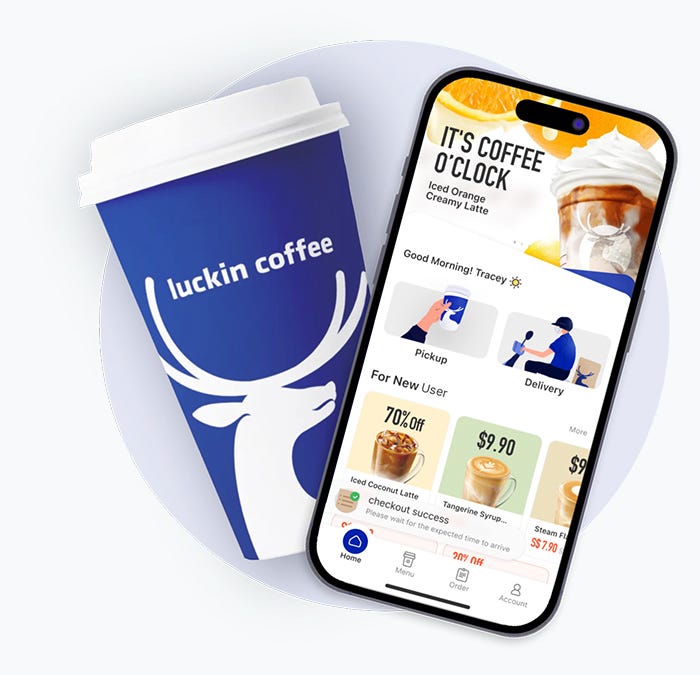
Marketers today are equipped with an unprecedented array of technological tools, from augmented reality (AR) and native apps to GPS, mobile phones, and machine learning. Yet, despite these advanced resources, many companies continue to face challenges in delivering exceptional customer experiences.
In this article, I wanted to highlight a company that integrates some fo the above technologies to craft an outstanding consumer experience. I’ll go into key insights and valuable lessons from my encounter with Luckin Coffee.
Luckin Coffee, a renowned coffee chain originating from Mainland China, has recently expanded to Singapore. I had the chance to experience their first stores there and was particularly impressed by their smart and strategic approach to onboarding customers.
I acknowledge that the dynamics of selling coffee differ from those of selling furniture, for example. However, certain foundational psychological principles and UX concepts remain universally applicable across industries. Leveraging these principles can provide valuable insights and strategies tailored to your specific market.
One Customer Experience
The challenge for marketers today is that there are too many technologies to choose from and then there is always the next “shiny object” that we feel pressured to adopt. Luckin crafts its customer experiences around a good old native app (iOS and Android) that gives the customer one touchpoint to order, locate a store, check their point balance, see the latest deals, and even leave feedback.
The native app, as the main touchpoint for consumer interactions, creates a win-win scenario. Customers enjoy a simplified brand experience, while the brand efficiently collects data from a single source to enhance customer profiling and analysis. The secret to Luckin’s success lies in offering users a multitude of features, each contributing to a rich tapestry of data points. This abundance of data is instrumental in refining and enhancing the user experience.
This strategy also addresses two of the biggest native apps challenges for a brand:
- To encourage consumers to download your app early in their relationship with your brand, it’s crucial to offer a compelling incentive. This is particularly important considering consumers’ concerns about storage space, battery drainage, and security. Luckin Coffee effectively addresses this hurdle by offering an enticing incentive: coffee for just 99 cents. This strategy not only incentivizes the initial download but also promotes a positive first impression and immediate value.
- 50–60% of users will uninstall your app after 30 days and the number one reason is that people just don’t have a use for the app. Luckin’s answer to this is to give the user a lot of reasons to use the app. In fact, you need the app to place an order (there is no barista to take your order).

The learnings:
- Native apps in general remain at the forefront of delivering superior customer experiences, primarily due to their rapid information loading, extensive functionality (including GPS, camera integration, etc.), and the rich data they provide to developers for enhancing and personalizing the user experience. Luckin Coffee effectively uses these features to elevate customer interactions. For instance, the app uses GPS to automatically detect my location, suggesting nearby stores from which I can order. Additionally, it employs the camera functionality to scan QR codes when I pick up my order, streamlining the ‘order received’ process and ensuring a smooth, efficient experience.
- Simplify Customer Interactions Across Your Brand Platforms: Opt for a unified approach when designing customer touchpoints. It’s not mandatory to develop a native app; alternatives like web apps can be equally effective. The key is to avoid directing customers to multiple destinations for different needs. Today’s consumers seek a seamless experience and are unconcerned with the complexities of your internal IT infrastructure. Focus on creating a cohesive, user-friendly journey for them.
A Smart Step-by-Step Process
What really stood out to me in Luckin’s onboarding process was their focused and systematic approach towards selling the first cup of coffee. This might seem straightforward, but many brands often clutter the process by trying to achieve too much at once, resulting in a confusing and unoptimized experience. Luckin’s strategy, with its clear and singular goal, highlights the effectiveness of simplicity and focus in customer engagement.
Phase 1: Onboarding & Activation
Incentive & QR code:
It starts with a simple QR code that leads you to a website where you can either download the app or place your order for a 99 cents coffee of your choice through a website. Always give people a choice online because if you force them, they will just leave (one of the ten usability heuristics). Again, remember your goal is to sell a cup of coffee, not necessarily get an app download or get the customer's pet’s name.
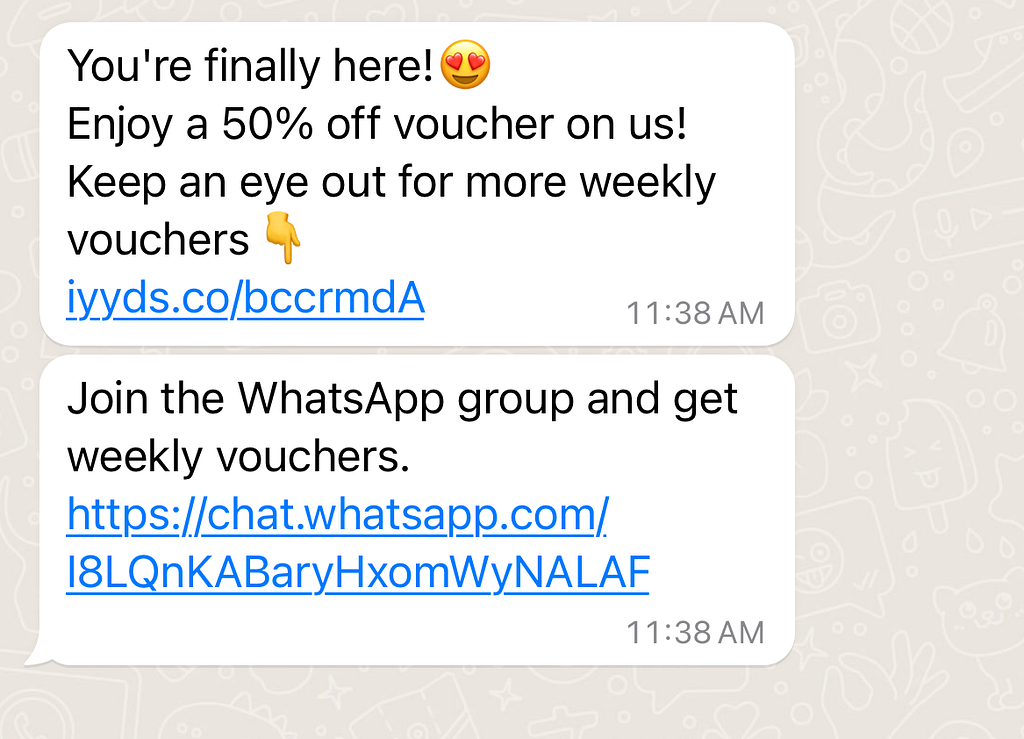
Progressive Profiling:
The only information required to place your order is your phone number, this makes the process super simple. Avoid asking for too many pieces of information from the user during the first visits. User will just drop off. What you want to do is, ask for this information later in the process, which is called progressive profiling. The way Luckin is doing this by offering more discounts if you join their WhatsApp group.
Seamless Payment:
To be honest, I had to remind myself just now how I am paying on Luckin’s app, which shows how easy they made it for me. They are utilizing Google Wallet or Apple Pay, which means you just need to show your face or fingerprint to pay. With all the seamless payment methods available, please don’t ask your customers to fill in their credit card information manually.
Gathering Feedback:
After every order, you have a chance to rate your order with a simple smiley or frown. A latter will immediately trigger a follow up questions and offer you connect to customer service; another usability heuristic.
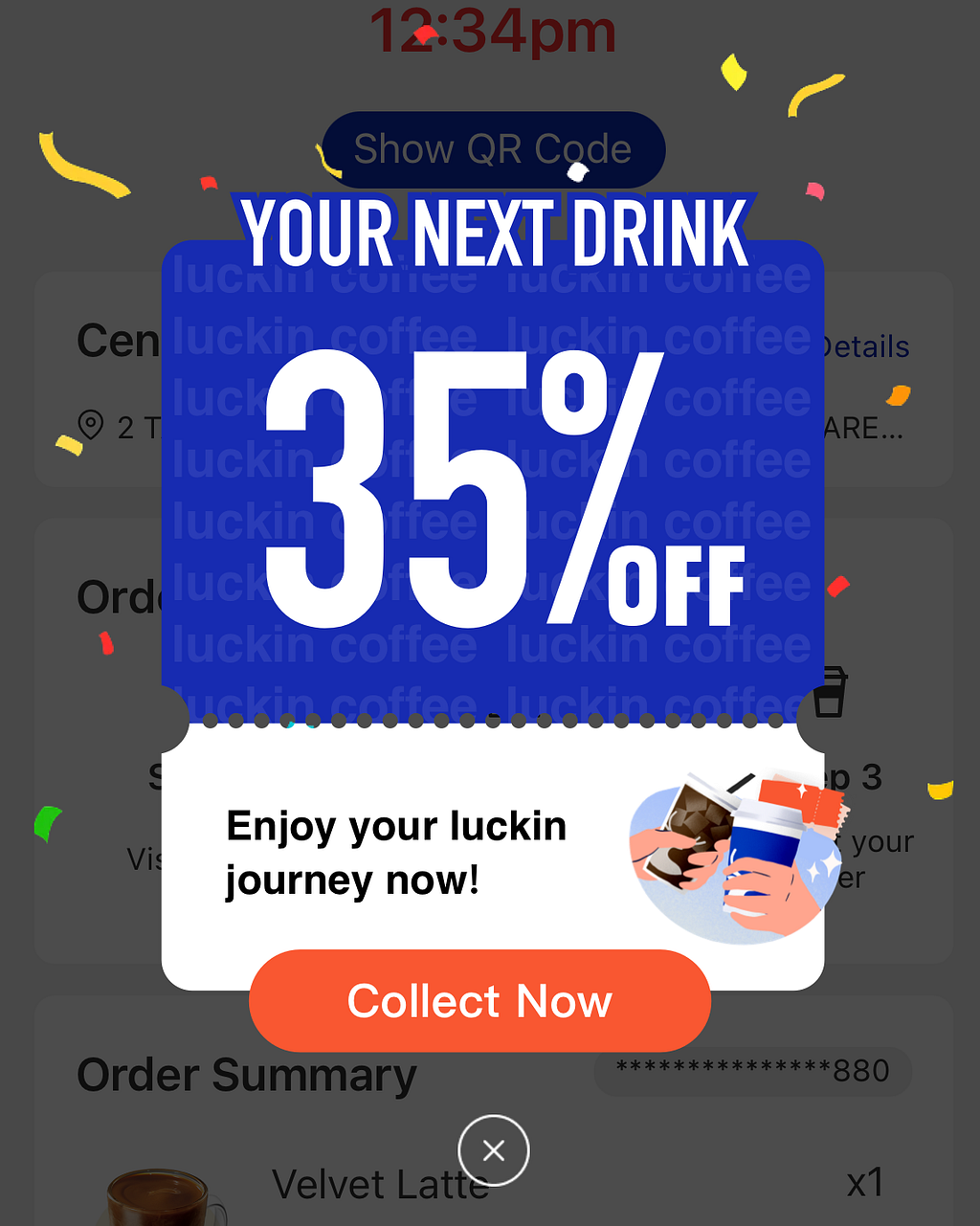
Phase 2: Retentions
Weekly discounts:
Now that you’ve placed your first order, the strategy shifts towards ensuring your repeat purchases. This is achieved through a proactive and consistent approach, involving weekly discounts coupled with regular reminders about their impending expiration to create a sense of urgency. This tactic of offering ongoing incentives is, in my opinion, a more effective strategy than a single, one-time ‘please come again’ coupon, as it keeps the customer engaged and encourages continuous interaction with the brand.
Phase 3: Advocacy & Loyalty
Refer a friend:
Finally, once you are frequent customer, Luckin will incentive you to refer your friends; offering more 99 cents coffees. Again they make things very simple and give you a link that you can just send to your friend via WhatsApp, email or any other channel.
Point program:
Selling coffee being a competitive business, of course there will be a loyalty program that will reward you as you drink more and more coffee at Luckin.
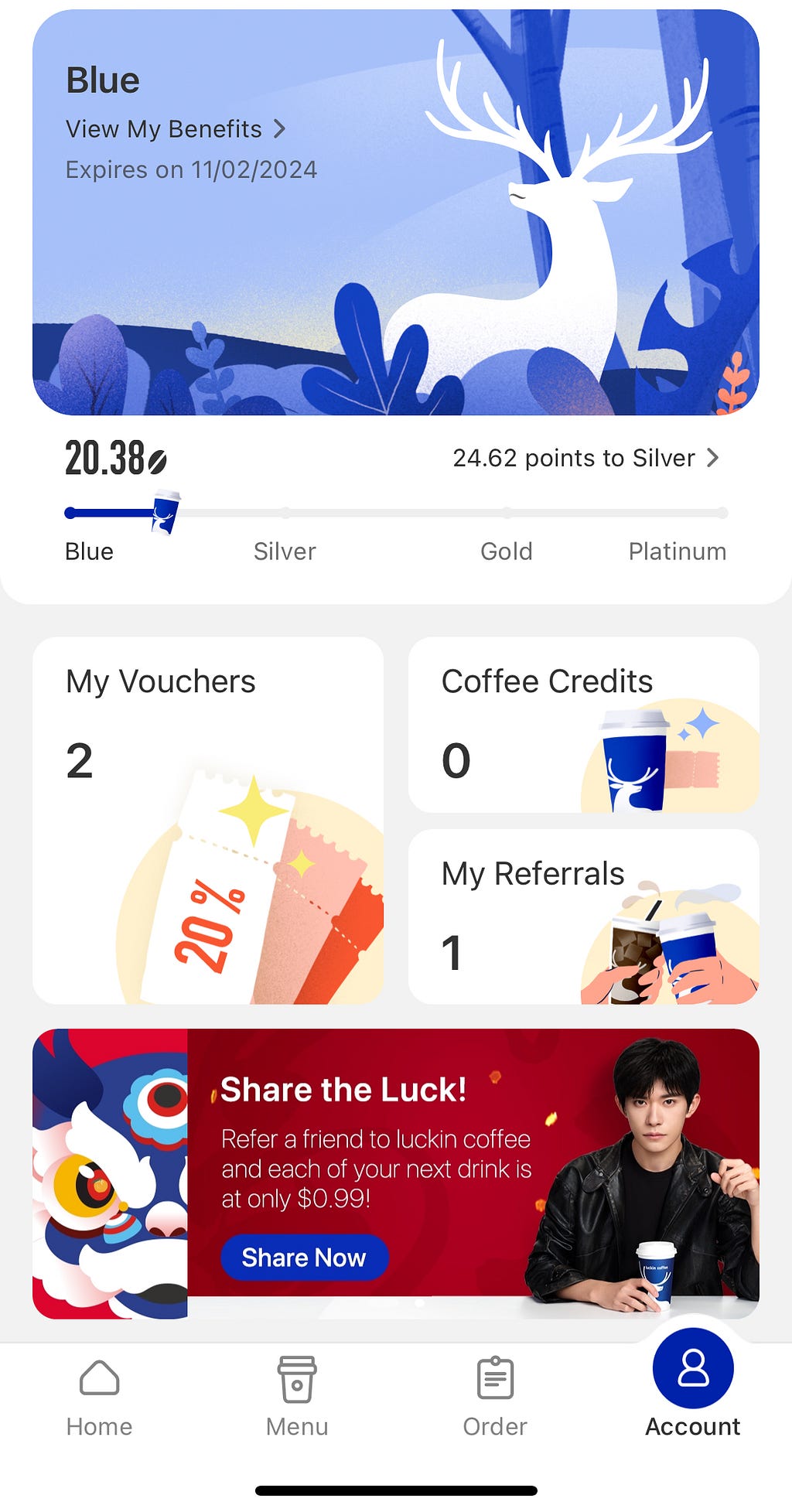
Conclusion
The brilliance of Luckin’s onboarding process lies in its remarkable simplicity. They’ve streamlined it to the point where the onboarding seamlessly transitions into the first transaction, effectively bypassing the conventional step of issuing a coupon and hoping for future redemption. This approach not only simplifies the customer’s journey but also immediately engages them in a purchase, setting a new standard in customer onboarding efficiency.
Finally, remember, while the initial goal is just a purchase, your long term goal is to fostering a lasting relationship. By prioritizing the customer’s ease and satisfaction, you lay the foundation for a loyal customer base. Embrace this challenge, and watch as your efforts translate into customer relationships that drive business impact.
Mastering onboarding: Key lessons from Luckin Coffee’s strategy was originally published in UX Collective on Medium, where people are continuing the conversation by highlighting and responding to this story.
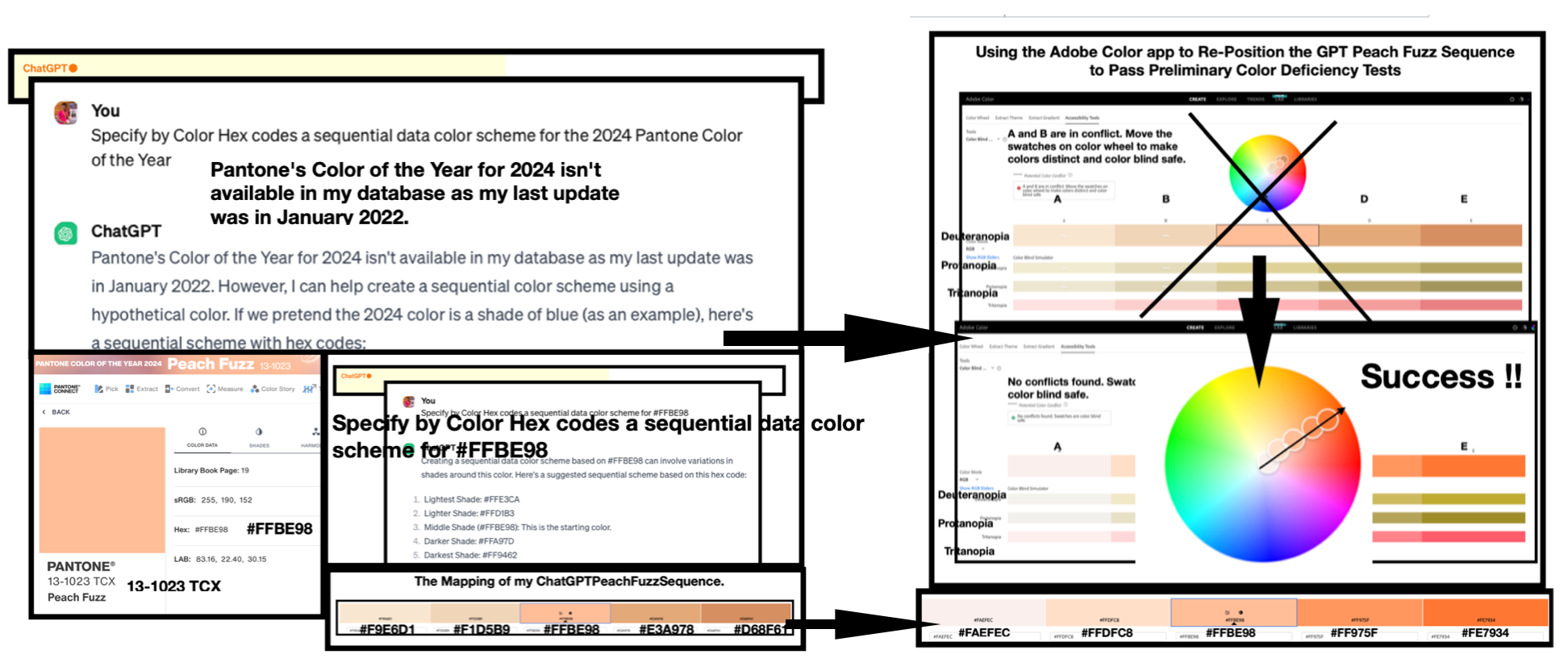

Leave a Reply